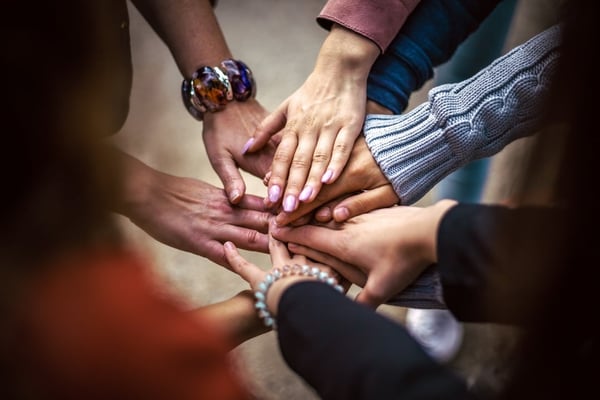Susanne Martinsson is a midwife in Skåne Region and has been working for the UM Skåne Online virtual clinic since its launch in September 2017. When we met with the youth clinic the last time, they had just started up their digital operations. Now we are curious about what has been happening since then and, most of all, how they have managed to achieve just over 400 video consultations a month!
Now you’ve been up and running with UM Skåne online for almost a year and a half. What has happened since the launch?
The format is the same, we have a digital drop-in clinic, where we offer young people between 12 and 23 years video consultations with a midwife, counsellor, or nurse. Initially, the entire focus was on starting up the service and getting the digital consultations started. We have gathered more experience over time, and digital contact is currently part of our everyday life. Digital consultations are now being used in earnest, with just over 400 calls a month – an impressive figure!
What have you done to get there?
We’ve spent a lot of time out there, informing both staff and young people that we are there. We have visited schools and recreation centres and put up posters. At the same time, we’ve talked to staff, travelled around practices and involved unit managers. It’s important for us to have involved the staff, because they are a major source for the dissemination of information about the service.
Another contribution to the increase in calls was that we chose to mention UM Skåne online in our answering machine message: ‘Did you know you can contact us online?’. Then it really started to take off!
“They can make calls when they’re out walking, travelling by train or even when they’re horseback riding!”
-Susanne Martinsson
Do you promote your digital clinic in other ways?
We have had targeted mailing via Facebook to reach young people in municipalities that lack a physical youth clinic. In addition, we have posted information on the youth clinics’ websites.
What do the staff think about meeting young people via video?
When we started with video consultations, there were a few mixed emotions, as there are often in the implementation of changes. But over time, everyone has become more positive and understands the importance of accessibility. Digital consultations are also found to be a natural part of the development. The internet is, of course, the arena for young people, and we have to keep up and be present where they are.
The drop-in arrangement works well, it is very accessible and young people can meet us when it suits them. What’s important is that it’s simple and straightforward, and it is! It allows you to book a repeat consultation, for example, to see a counsellor, if young people wish to do so, or if a follow-up is needed.
What have you done to help staff get started with digital consultations?
Beginners are given an introduction and sit next to more experienced people when working with video consultations, and they then have the opportunity to test themselves. But the fact is that no one among the staff seems to have experienced it as difficult, despite their different ages and digital experience. It’s simple and convenient! If anyone has ever had any difficulty with technology, it has almost always been due to a lack of connectivity on the recipient’s end.
How many people work for UM Skåne online?
In terms of roles, there are two counsellors, two midwives, and a nurse working at the clinic. But since no one works full time with video consultations, there are many more people, certainly more than 15, who work regularly with UM Skåne online. Everyone works from their workplace at a physical clinic. We currently operate from two units; partly from Hässleholm, where we started the service, and partly from Malmö, which was set up later. One advantage of this is that there are several of us who can support each other as needed, so we are not as vulnerable in the event of illness, relocation, or other things that affect resource planning. At the same time, the rest of the staff become more involved. Over time, we might need to add more units.
How does it work to operate in parallel with both physical and digital meetings?
We cannot book physical and digital consultations in the same system, but this has not caused any major problems. You often spend the whole day working with online meetings, which is good, as you really get the opportunity to focus. Overall, I think the combination of physical and digital is the ultimate thing, for both patients and staff. Digital and physical consultations should complement each other! Digital contact may be problematic for some young people, such as those suffering from severe dyslexia or visual impairment. At the same time, it opens up opportunities for young people living at a distance from a physical clinic to finally talk to us. That’s precisely why we see it as a good complement; the one does not rule out the other.
When do you think a digital meeting works particularly well?
It works incredibly well, no matter where the young people might be. They have contacted us from London, Taiwan, and other places, and it worked great. Young people’s ability to meet with us wherever they are means they have countless options. They can make calls when they’re out walking, travelling by train or even when they’re horseback riding! It enables them to contact us when they have the opportunity to do so.
We have also had video consultations with 12-year-olds, who have been able to contact us in a joint conversation with their parents. It seems like a good way to reach this group too.
What are your plans going forward?
Now that we’ve been up and running for a while, we have started to evaluate how we work, in order to plan for the future. We are in the process of establishing target scenarios for the best way for us to use the service and implement it in operations. For example, we are discussing how the service will work in our permanent operations, how we can guide young people even better by filtering, and whether we can redirect more callers towards using the app. Hopefully, we’ll have new goals to work towards later in the spring!


